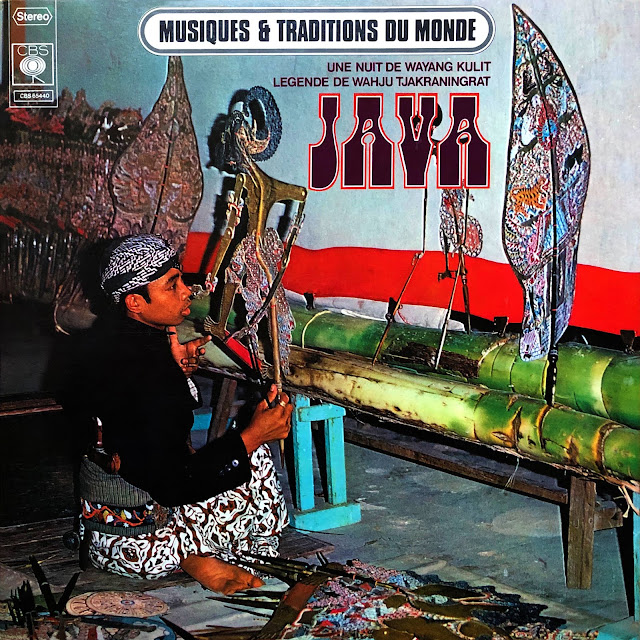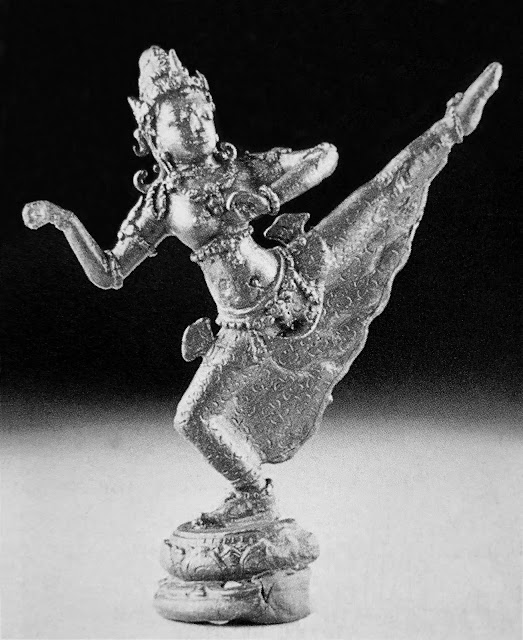Java – Glagah Wangi Gamelan conducted by Kardi Rahardjo Pramono – Une Nuit de Wayang Kulit / Légende de Wahju Tjakraningrat – CBS 65440, recorded by Jacques Brunet in 1971 (LP)
This beautiful
album, recorded by Jacques Brunet in the village of Glagah Wangi, Central Java,
in 1971, presents music accompanying a traditional performance of a Javanese Wayang Kulit shadow puppet theatre play,
which often represent episodes taken from great Hindu Ramayana and Mahabharata
epics.
The central
character in these nightly public performances, lasting from 9 pm to dawn, is
the dalang. Here the 17-year-old
dalang puppet master, Sudarmin, who performs The Legend of Wahju Tjakraningrat from the Mahabharata, fulfils this demanding role requiring great skill, erudition
and energy: for eight hours he must sing and precisely narrate the text,
improvise, change voices for each character, and gracefully animate the wayang puppets (see the album's front cover).
Sudarmin’s
performance is accompanied by a gamelan ensemble directed by Kardi Rahardjo
Pramono – including metalophones, gongs, kendang
drums, a two-string rebab bowed
violin, a suling flute, an 18-string tjelempung zither, and female voices –
which together create a rich, fluid and ethereal musical atmosphere.
According to
Brunet, “The Javanese shadow puppet theater is perhaps the world’s only “total
spectacle,” which achieves a perfect symbiosis between poetry, song, music, the
visual arts, mime, theater and gesture through the grace of magic and deep
mysticism.”
Cet magnifique album,
enregistré par Jacques Brunet dans le village de Glagah Wangi, au Java central,
en 1971, présente une musique accompagnant du théâtre d'ombres traditionnel Wayang Kulit, qui met en scène des épopées tirées du Ramayana ou du Mahabharata.
Le personnage central
lors de ces représentations publiques nocturnes, qui se déroulent de 21 h à
l'aube, est le dalang. Ici, le jeune maître marionnettiste Sudarmin, qui interprète La Légende de Wahju Tjakraningrat du Mahabharata, remplit ce rôle exigeant
qui nécessite une grande érudition, beaucoup d'énergie et de nombreux talents: huit heures
durant, il doit chanter et narrer précisément les textes, improviser, changer
de voix pour chaque personnage et animer gracieusement les marionnettes wayang.
Le spectacle de
Sudarmin est accompagné par un ensemble de gamelans dirigé par Kardi Rahardjo
Pramono – comprenant des métalophones, des gongs, des tambours kendang, une vièle à archet rebab, une flûte suling, une cithare tjelempung
à 18 cordes et des voix de femmes – qui tisse des sonorités riches, fluide et célestes.
Selon Jacques Brunet, “ Le théâtre
d'ombres javanais est peut-être le seul – spectacle total – au monde où la
symbiose est parfaitement réalisée entre la poésie, le chant, la musique, les
arts plastiques, le mime, le théâtre et le geste par la grâce de la magie et
d'une profonde mystique. ”
Download
Our other Javanese gamelan posts:
Gamelan Garland - Gamelan Kjai Kanjut Mesem/Mangkunagaran Surakarta (1968) here
Gamelan Kjahi Kaduk, Manis Rengga - Gamelan Music from Java (1963) here
Musique de Java - L'Ecole de Loka Wangi (1971) here
Sunda – Gamelan Degung directed by Enip Sukanda (1972) here

Sunda – Gamelan Degung directed by Enip Sukanda (1972) here

Photographs below are from L'Art de l'Asie du Sud-Est, Citadelles & Mazenod, 1994:
Ganesh from Candi Banon, Central Java, stone, 8th-9th century:
Vajran Ritya, Goddess of Dance, Surocolo, Central Java, bronze, 10th century:
Please help me purchase important traditional records to pursue my global curation project and share the best finds with you on this blog:












Teşekkürler...
ReplyDelete